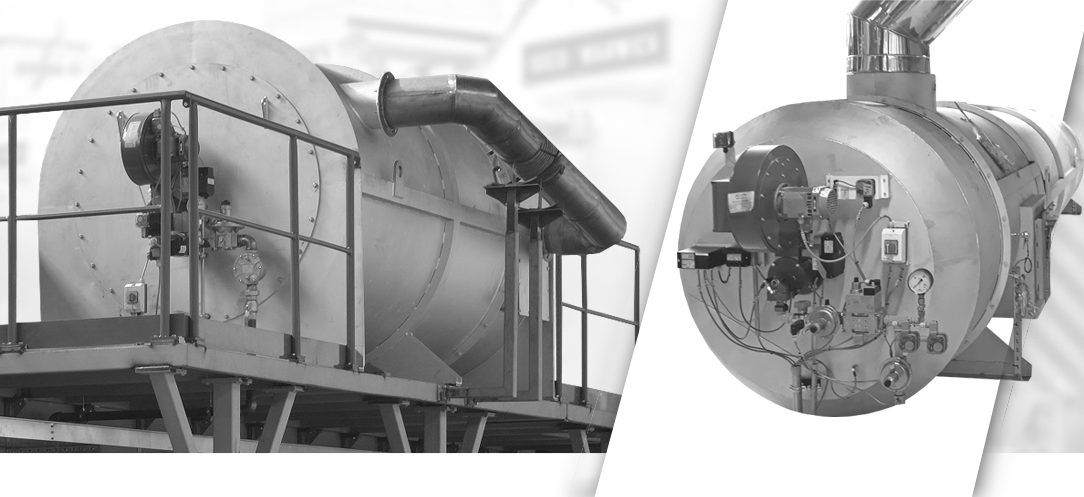
VOC Thermal Oxidizer – an Afterburner for reducing Harmful Emissions
VOC thermal oxidizers have been used to mitigate harmful emissions from Aluminum heat exchanger production lines for decades. That same afterburner solution is now applied to aluminum coil annealing in Mass Flow and Vortex® furnaces.
Thermal afterburners are used in the automotive and aluminum industries to destroy industrial contaminants such as volatile organic compounds (VOC), in particular aromatic hydrocarbons.
Large quantities of oil are often used for aluminum roll-forming. The oil vaporizes during heat treating, emitting hazardous organic compounds. To prevent these VOCs from threatening health and the environment, the heat treat furnace exhaust is run through an afterburner to ensure complete combustion of hazardous compounds. Afterburners are typically supplied together with the degreaser units included with controlled atmosphere brazing (CAB) lines. As emission mitigation efforts have increased, afterburners are also frequently paired with mass flow and Vortex aluminum annealing furnaces.
Volatile Organic Compounds (VOC) are a group of organic compounds which easily volatilize or vaporize with the presence of sunlight. At the same time, they release hazardous substances to the environment. VOC contain various chemicals. Some of them can have short- and long-term negative effects on health. Short-term effects on health include eye, nose and throat irritation, headaches, coordination impairment and nausea. Long-term effects can cause serious liver, kidney and central nervous system failure. Long-term exposure to high concentrations of VOC can cause cancer. In a thermal afterburner, after heating up to an appropriate temperature, the VOC industrial contaminants act as fuel, sustaining the combustion reaction on their own. During the combustion process, the contaminants are chemically transformed into neutral by-products, such as water and carbon dioxide, that can be safely discharged as flue gas. Due to the high process temperature, thermal afterburners are usually fitted with an energy-recovery system. The heat-recovery systems make it possible to reduce energy consumption by up to 70%.
/ combustion of volatile organic compounds,
/ reduction of VOC emissions,
/ gas heating system comprising one compact gas burner with gas path,
/ high-efficiency insulation of the combustion chamber,
/ independent control system equipped with a safety system in case of flame extinction.
/ complete combustion of volatile organic compounds even at temperatures as low as 650°C
/ high reduction of VOC (Volatile Organic Compounds) emission, down to 50 mg/Nm3 Total Organic Carbon (TOC), even down to 30 mg/Nm3 TOC in selected applications
/ complaint with European standards
/ afterburner can be retrofit to already operating furnace systems
/ aluminum brazing,
/ heat treatment of metals.
/ aviation
/ automotive
/ In the case of oily loads, Total Organic Carbon (TOC) emissions are reduced below limits.
/ Ecological, bio-soluble insulation with a properly selected thickness minimizes heat losses through the walls.
FAQ
What are VOCs and how to remove them from the aluminum coil annealing furnace?
Volatile Organic Compounds (VOC) are a group of organic compounds which easily volatilize or vaporize with the presence of sunlight. At the same time, they release hazardous substances to the environment. VOC contain various chemicals. Some of them can have short- and long-term negative effects on health. Short-term effects on health include eye, nose and throat irritation, headaches, coordination impairment and nausea. Long-term effects can cause serious liver, kidney, and central nervous system failure. Large quantities of oil are often used during the aluminum flat rolled products manufacturing and corrugation process. The oil evaporates during the heat treatment process, emitting hazardous organic compounds. VOC combustion process that takes place in Thermal Oxidizer guarantees low Total Organic Carbon emission rate compliant with allowed norms. Industrial pollutions act as an additional fuel source when heated to the appropriate temperature. The same ensuring VOC high efficiency combustion. During combustion, impurities are chemically transformed into harmless by-products such like water and carbon dioxide. Afterwards, it can be safely discharged as exhaust gases. Because of that the VOC Thermal Oxidizer is used by industries like aluminum rolling mills, food packing, cans, paper production, automotive etc. to protect the health and the environment.
Which VOCs removal equipment is the most economical and efficient?
VOC Thermal Oxidizer is relatively small and inexpensive device but it’s very effective to protect the environment by combustion of Volatile Organic Compounds. Our equipment can be gas or electrically heated and dedicated to installations where a large amount of oil exists in the load. It can be equipped with a heat exchanger installed around the combustion chamber, reducing energy consumption up to 50%.







